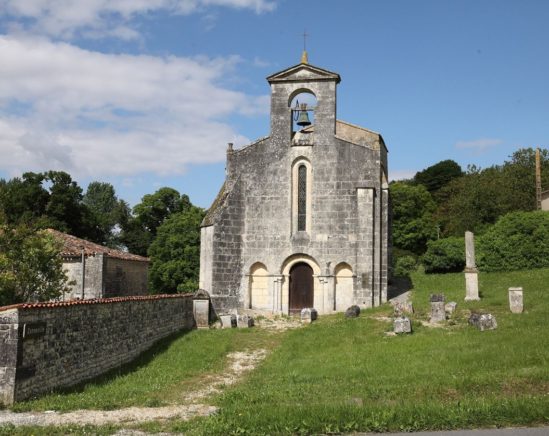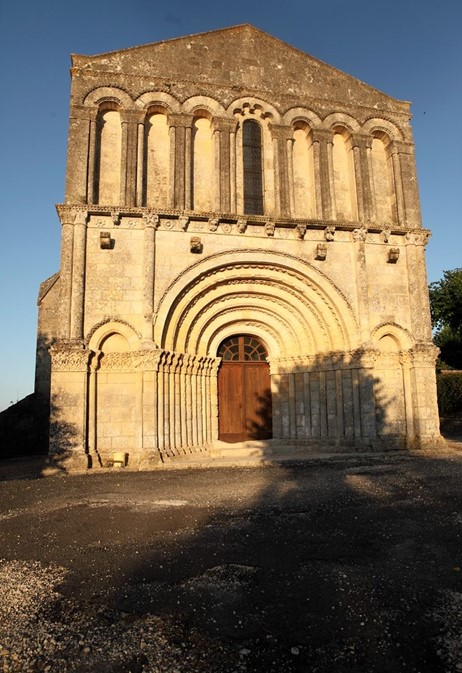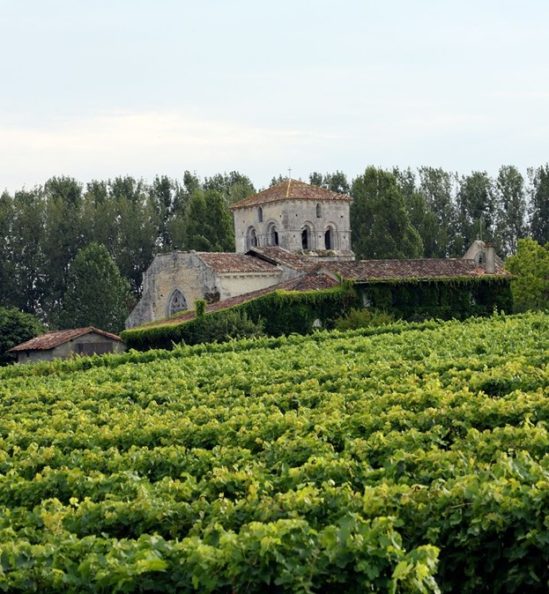The landscapes of Cognac – the Romanesque church, a stone building in the heart of the vineyard
In the heart of a village or isolated in the middle of the vineyards, the Romanesque churches built in the Middle Ages punctuate the vast landscapes of Cognac. Remarkable examples…

The Saint-Pierre de Sonneville church dates from the 12th century. It is of archaic Romanesque style. The facade is pierced, on the first floor, by three openings, two of which are blind and broken, framing the semi-circular entrance door. The front wall is crowned with a bell tower as high as the bell tower.
Échebrune
It is necessary to have followed these roads to the east of Pons which, after having undulated in the middle of the cultures, the meadows and the vineyards, start to climb some ample hills to embrace at their top a new landscape, a new panorama. The surrounding view lets us guess here a bell tower, there the remains of a windmill, in the distance some patches of greenery or the edge of a wood. It is at the bend in the road that we discover, perched on a hill at 70 m altitude, the village of Echebrune with its oppidum-like appearance. The presence of a religious building in the heart of the village is not surprising: for our distant ancestors, these high points were easily defensible sites and often places where people gathered to worship nature or divine forces; the expansion of Christianity and the flowering of churches in the 11th century led to the construction of buildings on these same “sacred” places.
It is thus a village that gradually settled around the Saint-Pierre church built in the 12th century. Its importance attests to the presence in the Middle Ages of an active and relatively large community. Overlooking the village and the church, the eye immediately falls on the imposing octagonal bell tower that seems to watch over the vast landscape that surrounds it. If the facade with its three floors remains a model of balance, it is especially the five perfectly balanced voussoirs of the porch which, similar to a silent conch, invite the spectator to let himself be bewitched by these “stones that sing” and by the magic that takes place at the sight of these beautiful arches springing from the facade like a call to the infinite.
Ambleville
Running through the regular and gracefully curved hillsides of what is today called the Grande Champagne, it is here the omnipresence of the vine that prevails over any other culture. Here and there, speckling the space with their yellow or green colors in the summer, there are plots of cereals that emerge like islands from this sea of vines… In the middle of these well-ordered rows undulating like waves according to the relief, breaking with this impression of infinity… Here the bed of a brook marked by its border of alders and ashes, there the white road which lazily curves in the side of the hill, there still a bell-tower which emerges letting guess the stone building which it surmounts.
The impression of isolation of the church of Ambleville is all the stronger since the church, flanked by its cemetery, is isolated in the countryside. The door with its semi-circular arch decorated with a simple diamond-pointed chord, the absence of decoration on the facade and on the upper floor are the sign of a stripping down and a deliberate sobriety that can be found in the whole building. The same desire for simplicity prevailed in the construction of the bell tower: the massive appearance of this rectangular tower decorated with imposing Romanesque windows is further accentuated by the flattened shape of the roof that shelters the bell tower. Dedicated to Saint Peter, the Romanesque church of Ambleville still shines in its discreet Champagne valley, a white stone décor set against the vineyard whose pure lines stand out against the surrounding background of trees, thus completing this soothing picture that seems to defy time.

The Saint-Pierre d’Échebrune church has a beautiful facade decorated with a series of arcatures dominating the main portal and its series of voussoirs.
Sonneville
If the expression “green setting” is a commonplace when speaking of a landscape, it is here in Saint-Pierre-de-Sonneville that it takes on its full meaning. In this landscape of the Rouillacais where the vineyards still compete with a conquering polyculture, it is the convergence of these hills covered with vines, graciously inclining as if leaning towards a cradle, that gives the site of Sonneville all its flavor. Embedded in this valley, the church is surrounded by a crown of protective trees, while at the entrance the old cemetery welcomes you, discreetly affirming an ancestral spiritual presence.
There is no village around the church, but an almost monastic solitude. At the bend in the road adjacent to the site, a simple low wall directs your gaze towards a high facade surrounded by buttresses and pierced by a graceful long window. The ensemble, enhanced by an openwork bell tower, composes a beautiful symphony of stone, all in simplicity. With its pilgrimage chapel appearance, the church of Sonneville, despite the wounds of time, still accompanies with its simple and uncluttered silhouette the unchanging rhythm of the seasons and the changing colors of the surrounding landscape.

The Saint-Pierre d’Ambleville church seems to emerge from a sea of vines.
Its bell tower pierced with bays is typical of the Romanesque churches of the Cognac region.
© Michel Guillard




